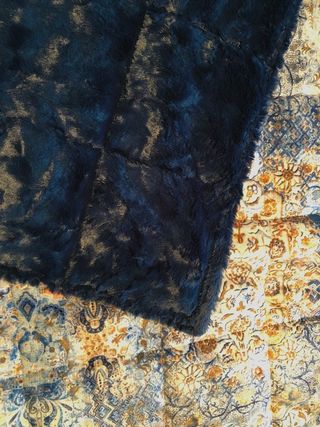Sleep
Should You Be Sleeping with a Weighted Blanket?
Deep Pressure Stimulation may enhance well-being.
Posted December 8, 2018 Reviewed by Kaja Perina

Touch has long been studied and found to be extremely healing. Empirical evidence shows how touch decreases blood pressure, heart rate, levels of emotional and physical pain, and significantly reduces the stress hormone, cortisol. Touch also does more amazing things. It strengthens our immune system, boosts blood circulation, increases the feel-good hormone, oxytocin, and, serotonin, the body’s pain-reducing hormone. All of these benefits make touch a meaningful way to find relief and comfort.
Touch involves pressure, and studies have shown that deep pressure holds the key to well-being. Clinically called Deep Pressure Stimulation, DPS is a type of firm but gentle pressure applied with the hands and arms via hugs, an embrace, a squeeze—and more formal approaches like massage therapy, chiropractic medicine, occupational and physical therapy, and weighted products.
Weighted Blankets
Weighted pressure, in the form of blankets, wraps, and vests, have been researched and proven to help children and adults with attention deficit disorders, anxiety, autism, distress, insomnia, and sensory disorders. Specifically, weighted blankets, sometimes called gravity blankets, increase serotonin and melatonin while also decreasing cortisol. This is why weighted blankets produce calm and peacefulness, as well as improve cognitive functioning in children and adults of all ages. Though there aren’t any studies assessing weighted blankets and mood disorders published (yet), I thought I’d give the experience and go and offer a case study self-report.
Tips for Weighted Blankets
Weighted blankets are different than regular blankets in that they’re designed to be significantly heavier. They are created for maximum deep pressure but allow for mobility and comfort. My research in finding weighted blankets took me from Amazon to retail stores, niche industries, to small businesses on Etsy. Here are some tips.
- Weighted blankets are pricey. Due to the specific manufacturing or customizable requests, expect to spend double and even triple digits. I purchased mine from Etsy for a little over 110.00 dollars.
- Fabric is a big deal. Many manufacturers and small business owners provide you with a choice of what your blanket can be made of. Cotton. Flannel. Fleece. Polyester. Soft, furry fabrics called Minky and a host of others. For me, I wanted a super-soft, washable blanket, so I chose a Minky design that was fluffy on one side and velvety on the other.
- There’s a general rule of thumb when customizing a weighted blanket, taking 10 percent of your weight for the blanket filler. So, for a child of 50 lbs., a blanket of 5 lbs. would be a good starting point. An adult weighing 100 lbs. would begin with 10 lbs. Manufacturers suggest you could choose less or more, depending on your level of comfort. After sampling a few different weighted blankets, I chose a blanket filled with 12 lbs.—less than the formula for my actual weight.
- Blankets are filled with many different things. Some are made with polypropylene pellets. River stones. Rice. Glass. Sand. And even beans. Depending on the filler, you may or may not be able to wash your blanket, so keep that in mind. My weighted blanket was filled with polypropylene pellets, and stitched in a series of channels and rows, like a checkerboard. It also had an additional inner layer of quilting batting, making it puffy-soft and breathable.
- The size of the blanket is recommended to fit your body, not the bed. I wanted a blanket I could use to sleep, but also one to rest with on the couch or in a chair. So, I chose a blanket that measured 48 x 72, twin size.
- Ready-made blankets can be purchased in stores and online, but most customizable ones will take several weeks to make. My blanket took 6 weeks. Was totally worth the wait.
Three Months of Use
From the moment the blanket arrived, I was startled by the heftiness of it. Though it was less than what was recommended for my weight, it was heavy. HEAVY. I wondered if I might be smothered by the thing when I put it on. I decided to wash it before using it and was surprised how well the blanket laundered in the machine and tumbled dry without incident.
My first experience with the weighted blanket was using it as I rested on the couch while reading. The oppressive heftiness I experienced holding it and carrying it around was totally different once I positioned it across my body. It felt wonderful. I was instantly relaxed.
Next, I used it for one of my daily catnaps, and it was remarkable. I felt snug, but not hot, and the pressure helped me float to sleep with an ease I’d never experienced before. The weight of the blanket was equally distributed across my body, even when I turned or shifted under its cover. I was amazed at how great it felt - and how great I felt.
Now, the true test was when I used the blanket on days that were stressful or when I felt down and melancholy. The deep pressure of the blanket immediately shifted my mood, reduced my irritability and helped me feel relaxed. I’ve also used it to sleep through the night many times, noting when I do, I fall asleep more quickly and feel fully rested when I awaken.
Final Thoughts on Weighted Blankets
For me, using a weighted blanket to enhance my well-being was impressive. As with many holistic approaches, it’s expected that individual experiences will vary. So, it’s important to remember this if you decide to try a weighted blanket.
I look forward to evidenced-based studies targeting how and if these blankets increase mood and lift symptoms of depression. But in my simple case study self-report, I can say without hesitation, "Yes, it did for me."
Facebook image: BublikHaus/Shutterstock




